 NIO
NIO
NIO
一、I/O模型
1、I/O模型的基本说明
IO 模型简单的理解:就是用什么样的通道进行数据的发送和接收,很大程度上决定了程序通信的性能。
UNIX 系统下, IO 模型一共有 5 种:同步阻塞 I/O、同步非阻塞 I/O、I/O 多路复用、信号驱动 I/O 和异步 I/O。
- 同步:线程自己去获取结果(一个线程)
- 异步:线程自己不去获取结果,而是由其它线程送结果(至少两个线程)
Java 共支持三种网络编程I/O模式:BIO, NIO, AIO
(1)BIO (Blocking I/O)
BIO 属于同步阻塞 IO 模型 。同步阻塞 IO 模型中,应用程序发起 read 调用后,会一直阻塞,直到内核把数据拷贝到用户空间。
(2)NIO (Non-blocking/New I/O)
Java 中的 NIO 于 Java 1.4 中引入,对应
java.nio包,提供了Channel,Selector,Buffer等抽象。NIO 中的 N 可以理解为 Non-blocking,不单纯是 New。它是支持面向缓冲的,基于通道的 I/O 操作方法。 对于高负载、高并发的(网络)应用,应使用 NIO 。
Java 中的 NIO 可以看作是 I/O 多路复用模型。也有很多人认为,Java 中的 NIO 属于同步非阻塞 IO 模型。
我们先来看看 同步非阻塞 IO 模型。
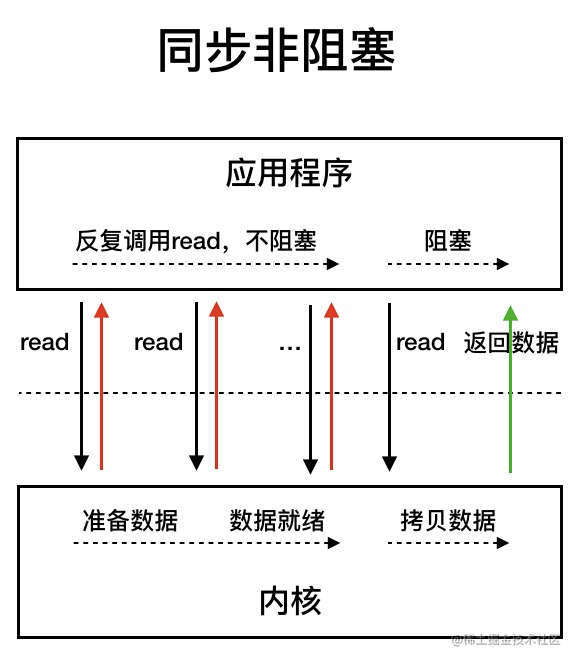
同步非阻塞 IO 模型中,应用程序会一直发起 read 调用,等待数据从内核空间拷贝到用户空间的这段时间里,线程依然是阻塞的,直到在内核把数据拷贝到用户空间。相比于同步阻塞 IO 模型,同步非阻塞 IO 模型确实有了很大改进。通过轮询操作,避免了一直阻塞。
但是,这种 IO 模型同样存在问题:应用程序不断进行 I/O 系统调用轮询数据是否已经准备好的过程是十分消耗 CPU 资源的。
这个时候,I/O 多路复用模型 就上场了。
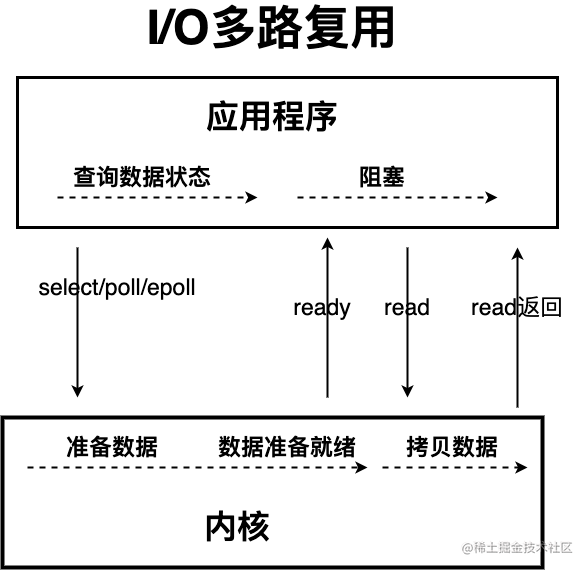
IO 多路复用模型中,线程首先发起 select 调用,询问内核数据是否准备就绪,等内核把数据准备好了,用户线程再发起 read 调用。read 调用的过程(数据从内核空间 -> 用户空间)还是阻塞的。
目前支持 IO 多路复用的系统调用,有 select,epoll 等等。select 系统调用,目前几乎在所有的操作系统上都有支持。
- select 调用:内核提供的系统调用,它支持一次查询多个系统调用的可用状态。几乎所有的操作系统都支持。
- epoll 调用:linux 2.6 内核,属于 select 调用的增强版本,优化了 IO 的执行效率。
IO 多路复用模型,通过减少无效的系统调用,减少了对 CPU 资源的消耗。
Java 中的 NIO ,有一个非常重要的选择器 ( Selector ) 的概念,也可以被称为 多路复用器。通过它,只需要一个线程便可以管理多个客户端连接。当客户端数据到了之后,才会为其服务。
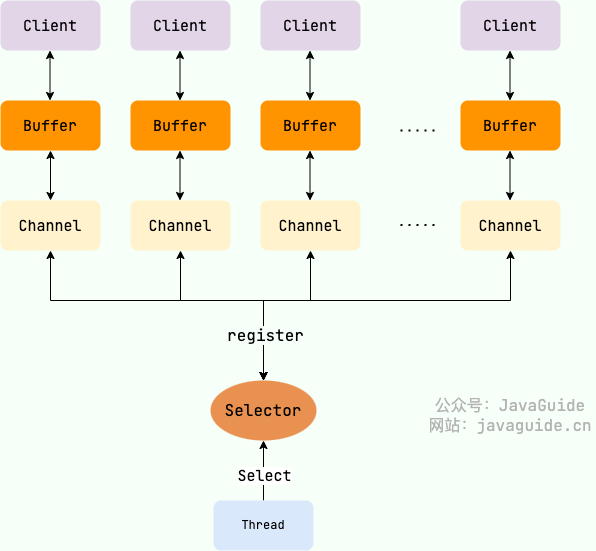
(3)AIO (Asynchronous I/O)
AIO 也就是 NIO 2。Java 7 中引入了 NIO 的改进版 NIO 2,它是异步 IO 模型。异步 IO 是基于事件和回调机制实现的,也就是应用操作之后会直接返回,不会堵塞在那里,当后台处理完成,操作系统会通知相应的线程进行后续的操作。
2、BIO、NIO、AIO使用场景
- BIO方式适用于连接数目比较小且固定的架构,这种方式对服务器资源要求比较高,并发局限于应用中,JDK1.4以前唯一的选择,但是程序简单容易理解。
- NIO方式适用于连接数目多且连接比较短(轻操作)的架构,比如聊天服务器,弹幕系统,服务器间通讯等。程序比较复杂,JDK1.4开始支持。
- AIO方式适用于连接数目多且连接比较长(重操作)的架构,比如相册服务器,充分调用OS参与并发操作,变成比较复杂,JDK7开始支持。
3、BIO问题分析
- 1、每个请求都需要独立创建线程,与对应的客户端进行数据Read,业务处理,数据Write;
- 2、当数据并发较大时,需要创建大量线程处理连接,系统资源占用较大;
- 3、连接建立后,如果当前线程暂时没有数据可读,则线程就阻塞在Read操作上,造成线程资源浪费。
二、Java NIO 三大组件
1、Channel & Buffer
channel 有一点类似于 stream,它就是读写数据的双向通道,可以从 channel 将数据读入 buffer,也可以将 buffer 的数据写入 channel,而之前的 stream 要么是输入,要么是输出,channel 比 stream 更为底层
常见的 Channel 有
- FileChannel、DatagramChannel、SocketChannel、ServerSocketChannel
buffer 则用来缓冲读写数据,常见的 buffer 有
- ByteBuffer
- MappedByteBuffer
- DirectByteBuffer
- HeapByteBuffer
- ShortBuffer、IntBuffer、LongBuffer、FloatBuffer、DoubleBuffer、CharBuffer
2、Selector
selector 的作用就是配合一个线程来管理多个 channel,获取这些 channel 上发生的事件,这些 channel 工作在非阻塞模式下,不会让线程吊死在一个 channel 上。适合连接数特别多,但流量低的场景(low traffic)
调用 selector 的 select() 会阻塞直到 channel 发生了读写就绪事件,这些事件发生,select 方法就会返回这些事件交给 thread 来处理
三、 ByteBuffer
1、使用方法
- 向 buffer 写入数据,例如调用 channel.read(buffer)
- 调用 flip() 切换至读模式
- 从 buffer 读取数据,例如调用 buffer.get()
- 调用 clear() 或 compact() 切换至写模式
- 重复 1~4 步骤
try (RandomAccessFile file = new RandomAccessFile("helloword/data.txt", "rw")) {
FileChannel channel = file.getChannel();
ByteBuffer buffer = ByteBuffer.allocate(10);
do {
// 向 buffer 写入
int len = channel.read(buffer);
log.debug("读到字节数:{}", len);
if (len == -1) {
break;
}
// 切换 buffer 读模式
buffer.flip();
while(buffer.hasRemaining()) {
log.debug("{}", (char)buffer.get());
}
// 切换 buffer 写模式
buffer.clear();
} while (true);
} catch (IOException e) {
e.printStackTrace();
}
2、ByteBuffer 结构
ByteBuffer 有以下重要属性
- capacity
- position
- limit
一开始

写模式下,position 是写入位置,limit 等于容量,下图表示写入了 4 个字节后的状态
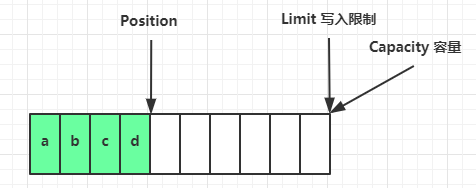
flip 动作发生后,position 切换为读取位置,limit 切换为读取限制

读取 4 个字节后,状态
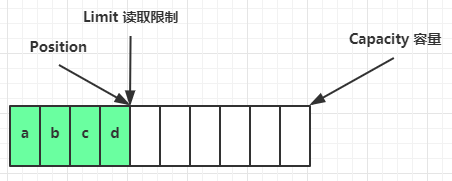
clear 动作发生后,状态
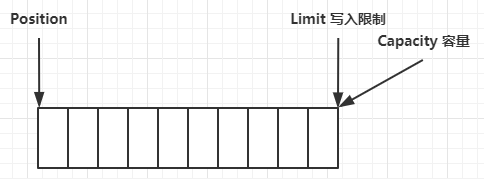
compact 方法,是把未读完的部分向前压缩,然后切换至写模式

注意
- Buffer 是无边界的数据缓冲区,需要自己解决粘包、半包问题 (长度信息、特定分隔符)
- Buffer 是非线程安全的
3、ByteBuffer 常见方法
(1)分配空间
可以使用 allocate 方法为 ByteBuffer 分配空间,其它 buffer 类也有该方法
Bytebuffer buf = ByteBuffer.allocate(16);
(2)向 buffer 写入数据
有两种办法
- 调用 channel 的 read 方法
- 调用 buffer 自己的 put 方法
int readBytes = channel.read(buf);
buf.put((byte)127);
(3)从 buffer 读取数据
同样有两种办法
- 调用 channel 的 write 方法
- 调用 buffer 自己的 get 方法
int writeBytes = channel.write(buf);
byte b = buf.get();
get 方法会让 position 读指针向后走,如果想重复读取数据
- 可以调用 rewind 方法将 position 重新置为 0
- 或者调用 get(int i) 方法获取索引 i 的内容,它不会移动读指针
(4)mark 和 reset
mark 是在读取时,做一个标记,即使 position 改变,只要调用 reset 就能回到 mark 的位置
ByteBuffer buffer = ByteBuffer.allocate(10);
buffer.put(new byte[]{'a', 'b', 'c', 'd'});
buffer.flip();
System.out.println((char) buffer.get()); // a
System.out.println((char) buffer.get()); // b
// 加标记,索引2 的位置
buffer.mark();
System.out.println((char) buffer.get()); // c
System.out.println((char) buffer.get()); // d
// 将 position 重置到索引 2
buffer.reset();
System.out.println((char) buffer.get()); // c
System.out.println((char) buffer.get()); // d
注意
rewind() 和 flip() 都会清除 mark 位置
(5)字符串与 ByteBuffer 互转
// 1.1. 字符串 -> ByteBuffer
ByteBuffer buffer1 = ByteBuffer.allocate(16);
buffer1.put("hello".getBytes());
// 1.2. Charset
ByteBuffer buffer2 = StandardCharsets.UTF_8.encode("hello");
ByteBuffer buffer3 = Charset.forName("utf-8").encode("你好");
// 1.3. wrap
ByteBuffer buffer4 = ByteBuffer.wrap("hello".getBytes());
// 2. ByteBuffer -> 转为字符串
buffer1.flip();
String str1 = StandardCharsets.UTF_8.decode(buffer1).toString();
String str2 = StandardCharsets.UTF_8.decode(buffer2).toString();
4、Scattering And Gathering
- Scattering: 将数据写入到buffer的时候,可以采用buffer数组,几次写入
- Gathering: 从buffer读取数据的时候,可以采用buffer数组,依次读
public class ScatteringAndGatheringTest {
public static void main(String[] args) throws Exception{
/**
* serverSocketChannel 和 socketChannel
*/
ServerSocketChannel serverSocketChannel = ServerSocketChannel.open();
InetSocketAddress inetSocketAddress = new InetSocketAddress(6666);
//绑定端口到socket,并启动
serverSocketChannel.socket().bind(inetSocketAddress);
//创建buffer数组
ByteBuffer[] byteBuffers = new ByteBuffer[2];
byteBuffers[0] = ByteBuffer.allocate(5);
byteBuffers[1] = ByteBuffer.allocate(3);
//等待客户端连接
SocketChannel socketChannel = serverSocketChannel.accept();
int messageLength = 8; //假设从客户端接收8个字节
while(true){
int byteRead = 0;
while(byteRead < messageLength){
long l = socketChannel.read(byteBuffers);
byteRead += l;
System.out.println("byteRead="+byteRead);
//使用流打印,看看当前buffer的position和limit
Arrays.asList(byteBuffers).stream()
.map(byteBuffer -> "position="+ byteBuffer.position()+",limit="+byteBuffer.limit())
.forEach(System.out::println);
}
//将所有buffer进行flip
Arrays.asList(byteBuffers).forEach(byteBuffer -> byteBuffer.flip());
//将数据读出显示到客户端
long byteWrite = 0;
while(byteWrite < messageLength){
long w = socketChannel.write(byteBuffers);
byteWrite += w;
}
//将所有buffer进行clear
Arrays.asList(byteBuffers).forEach(buffer -> buffer.clear());
System.out.println("byteRead="+byteRead + ",bytewrite="+byteWrite+",messageLength="+messageLength);
}
}
}
四、文件编程
1、 FileChannel
⚠️ FileChannel 工作模式,FileChannel 只能工作在阻塞模式
1)获取
不能直接打开 FileChannel,必须通过 FileInputStream、FileOutputStream 或者 RandomAccessFile 来获取 FileChannel,它们都有 getChannel 方法
注意
- 通过 FileInputStream 获取的 channel 只能读
- 通过 FileOutputStream 获取的 channel 只能写
- 通过 RandomAccessFile 是否能读写根据构造 RandomAccessFile 时的读写模式决定
2)读取
会从 channel 读取数据填充 ByteBuffer,返回值表示读到了多少字节,-1 表示到达了文件的末尾
int readBytes = channel.read(buffer);
3)写入
写入的正确姿势如下, SocketChannel
ByteBuffer buffer = ...;
buffer.put(...); // 存入数据
buffer.flip(); // 切换读模式
while(buffer.hasRemaining()) {
channel.write(buffer);
}
在 while 中调用 channel.write 是因为 write 方法并不能保证一次将 buffer 中的内容全部写入 channel
4)关闭
channel 必须关闭,不过调用了 FileInputStream、FileOutputStream 或者 RandomAccessFile 的 close 方法会间接地调用 channel 的 close 方法
5)位置
获取当前位置
long pos = channel.position();
设置当前位置
long newPos = ...;
channel.position(newPos);
设置当前位置时,如果设置为文件的末尾
- 这时读取会返回 -1
- 这时写入,会追加内容,但要注意如果 position 超过了文件末尾,再写入时在新内容和原末尾之间会有空洞(00)
6)大小
使用 size 方法获取文件的大小
7)强制写入
操作系统出于性能的考虑,会将数据缓存,不是立刻写入磁盘。可以调用 force(true) 方法将文件内容和元数据(文件的权限等信息)立刻写入磁盘
2、 两个 Channel 传输数据
String FROM = "helloword/data.txt";
String TO = "helloword/to.txt";
long start = System.nanoTime();
try (FileChannel from = new FileInputStream(FROM).getChannel();
FileChannel to = new FileOutputStream(TO).getChannel();
) {
from.transferTo(0, from.size(), to);
} catch (IOException e) {
e.printStackTrace();
}
long end = System.nanoTime();
System.out.println("transferTo 用时:" + (end - start) / 1000_000.0);
超过 2g 大小的文件传输
public class TestFileChannelTransferTo {
public static void main(String[] args) {
try (
FileChannel from = new FileInputStream("data.txt").getChannel();
FileChannel to = new FileOutputStream("to.txt").getChannel();
) {
// 效率高,底层会利用操作系统的零拷贝进行优化
long size = from.size();
// left 变量代表还剩余多少字节
for (long left = size; left > 0; ) {
System.out.println("position:" + (size - left) + " left:" + left);
left -= from.transferTo((size - left), left, to);
}
} catch (IOException e) {
e.printStackTrace();
}
}
}
3、 Path
jdk7 引入了 Path 和 Paths 类
- Path 用来表示文件路径
- Paths 是工具类,用来获取 Path 实例
// 相对路径,使用 user.dir 环境变量来定位 1.txt
Path source = Paths.get("1.txt");
// 绝对路径
Path source = Paths.get("d:\\1.txt");
Path source = Paths.get("d:/1.txt");
// 自动拼接,表示 d:\data\projects
Path projects = Paths.get("d:\\data", "projects");
// normalize 标准化路径
Path path = Paths.get("d:\\data\\projects\\a\\..\\b");
System.out.println(path.normalize()); // 输出 d:\data\projects\b
4、 Files
// 判断文件是否存在
System.out.println(Files.exists(path));
// 创建单级目录,已存在则抛出异常
Files.createDirectory(path);
// 创建多级目录,已存在也不抛异常
Files.createDirectories(path);
// 拷贝文件
Files.copy(source, target, StandardCopyOption.REPLACE_EXISTING);
// 移动文件
Files.move(source, target, StandardCopyOption.ATOMIC_MOVE);
// 删除文件/空目录
Files.delete(target);
遍历目录文件
// walk 返回一个文件流
Files.walk(path, maxDepth, options).forEach(path -> {...});
// walkFileTree 配合 FileVisitor 提供更加灵活的处理访问
Files.walkFileTree(Paths.get("C:\\Users\\chanper\\Downloads"), new SimpleFileVisitor<Path>() {
@Override
public FileVisitResult visitFile(Path file, BasicFileAttributes attrs) throws IOException {
System.out.println(file.getFileName());
return super.visitFile(file, attrs);
}
@Override
public FileVisitResult postVisitDirectory(Path dir, IOException exc) throws IOException {
System.out.println(dir.getFileName());
return super.postVisitDirectory(dir, exc);
}
});
删除多级目录
Path path = Paths.get("d:\\a");
Files.walkFileTree(path, new SimpleFileVisitor<Path>(){
@Override
public FileVisitResult visitFile(Path file, BasicFileAttributes attrs)
throws IOException {
Files.delete(file);
return super.visitFile(file, attrs);
}
@Override
public FileVisitResult postVisitDirectory(Path dir, IOException exc)
throws IOException {
Files.delete(dir);
return super.postVisitDirectory(dir, exc);
}
});
拷贝多级目录
long start = System.currentTimeMillis();
String source = "D:\\Snipaste-1.16.2-x64";
String target = "D:\\Snipaste-1.16.2-x64aaa";
Files.walk(Paths.get(source)).forEach(path -> {
try {
String targetName = path.toString().replace(source, target);
// 是目录
if (Files.isDirectory(path)) {
Files.createDirectory(Paths.get(targetName));
}
// 是普通文件
else if (Files.isRegularFile(path)) {
Files.copy(path, Paths.get(targetName));
}
} catch (IOException e) {
e.printStackTrace();
}
});
long end = System.currentTimeMillis();
System.out.println(end - start);
五、网络编程
1、 非阻塞 vs 阻塞
1)阻塞
- 阻塞模式下,相关方法都会导致线程暂停
- ServerSocketChannel.accept 会在没有连接建立时让线程暂停
- SocketChannel.read 会在没有数据可读时让线程暂停
- 阻塞的表现其实就是线程暂停了,暂停期间不会占用 cpu,但线程相当于闲置
服务器端
// 使用 nio 来理解阻塞模式, 单线程
// 0. ByteBuffer
ByteBuffer buffer = ByteBuffer.allocate(16);
// 1. 创建了服务器
ServerSocketChannel ssc = ServerSocketChannel.open();
// 2. 绑定监听端口
ssc.bind(new InetSocketAddress(8080));
// 3. 连接集合
List<SocketChannel> channels = new ArrayList<>();
while (true) {
// 4. accept 建立与客户端连接, SocketChannel 用来与客户端之间通信
log.debug("connecting...");
SocketChannel sc = ssc.accept(); // 阻塞方法,线程停止运行
log.debug("connected... {}", sc);
channels.add(sc);
for (SocketChannel channel : channels) {
// 5. 接收客户端发送的数据
log.debug("before read... {}", channel);
channel.read(buffer); // 阻塞方法,线程停止运行
buffer.flip();
debugRead(buffer);
buffer.clear();
log.debug("after read...{}", channel);
}
}
客户端
SocketChannel sc = SocketChannel.open();
sc.connect(new InetSocketAddress("localhost", 8080));
System.out.println("waiting...");
存在的问题
- 单线程下,阻塞方法之间相互影响,几乎不能正常工作,需要多线程支持
- 但多线程下,有新的问题,体现在以下方面
- 32 位 jvm 一个线程 320k,64 位 jvm 一个线程 1024k,如果连接数过多,必然导致 OOM,并且线程太多,反而会因为频繁上下文切换导致性能降低
- 可以采用线程池技术来减少线程数和线程上下文切换,但治标不治本,如果有很多连接建立,但长时间 inactive,会阻塞线程池中所有线程,因此不适合长连接,只适合短连接
2)非阻塞
- 非阻塞模式下,相关方法都会不会让线程暂停
- 在 ServerSocketChannel.accept 在没有连接建立时,会返回 null,继续运行
- SocketChannel.read 在没有数据可读时,会返回 0,但线程不必阻塞,可以去执行其它 SocketChannel 的 read 或是去执行 ServerSocketChannel.accept
- 写数据时,线程只是等待数据写入 Channel 即可,无需等 Channel 通过网络把数据发送出去
服务器端,客户端代码不变
// 使用 nio 来理解非阻塞模式, 单线程
// 0. ByteBuffer
ByteBuffer buffer = ByteBuffer.allocate(16);
// 1. 创建了服务器
ServerSocketChannel ssc = ServerSocketChannel.open();
ssc.configureBlocking(false); // 非阻塞模式
// 2. 绑定监听端口
ssc.bind(new InetSocketAddress(8080));
// 3. 连接集合
List<SocketChannel> channels = new ArrayList<>();
while (true) {
// 4. accept 建立与客户端连接, SocketChannel 用来与客户端之间通信
SocketChannel sc = ssc.accept(); // 非阻塞,线程还会继续运行,如果没有连接建立,但sc是null
if (sc != null) {
log.debug("connected... {}", sc);
sc.configureBlocking(false); // 非阻塞模式
channels.add(sc);
}
for (SocketChannel channel : channels) {
// 5. 接收客户端发送的数据
int read = channel.read(buffer);// 非阻塞,线程仍然会继续运行,如果没有读到数据,read 返回 0
if (read > 0) {
buffer.flip();
debugRead(buffer);
buffer.clear();
log.debug("after read...{}", channel);
}
}
}
存在的问题
- 但非阻塞模式下,即使没有连接建立,和可读数据,线程仍然在不断运行,白白浪费了 cpu
- 数据复制过程中,线程实际还是阻塞的(AIO 改进的地方)
2、Selector
单线程可以配合 Selector 完成对多个 Channel 可读写事件的监控,这称之为多路复用
- 多路复用仅针对网络 IO、普通文件 IO 没法利用多路复用
- 如果不用 Selector 的非阻塞模式,线程大部分时间都在做无用功,而 Selector 能够保证
- 有可连接事件时才去连接
- 有可读事件才去读取
- 有可写事件才去写入
- 限于网络传输能力,Channel 未必时时可写,一旦 Channel 可写,会触发 Selector 的可写事件
好处
- 一个线程配合 selector 就可以监控多个 channel 的事件,事件发生线程才去处理。避免非阻塞模式下所做无用功
- 让这个线程能够被充分利用
- 节约了线程的数量
- 减少了线程上下文切换
底层实现
Java NIO 会根据操作系统、JDK 版本、运行环境选择合适的底层实现,通常倾向于使用更高性能的 epoll 模型,以提供更好的性能和并发处理能力。
创建
Selector selector = Selector.open();
注册事件
channel.configureBlocking(false);
SelectionKey key = channel.register(selector, 绑定事件);
- channel 必须工作在非阻塞模式
- FileChannel 没有非阻塞模式,因此不能配合 selector 一起使用
- 绑定的事件类型可以有
- connect - 客户端连接成功时触发
- accept - 服务器端成功接受连接时触发
- read - 数据可读入时触发,有因为接收能力弱,数据暂不能读入的情况
- write - 数据可写出时触发,有因为发送能力弱,数据暂不能写出的情况
监听 Channel 事件
可以通过下面三种方法来监听是否有事件发生,方法的返回值代表有多少 channel 发生了事件
//方法1,阻塞直到绑定事件发生
int count = selector.select();
//方法2,阻塞直到绑定事件发生,或是超时(时间单位为 ms)
int count = selector.select(long timeout);
//方法3,不会阻塞,也就是不管有没有事件,立刻返回,自己根据返回值检查是否有事件
int count = selector.selectNow();
select 何时不阻塞
- 事件发生时
- 客户端发起连接请求,会触发 accept 事件
- 客户端发送数据过来,客户端正常、异常关闭时,都会触发 read 事件,另外如果发送的数据大于 buffer 缓冲区,会触发多次读取事件
- channel 可写,会触发 write 事件
- 在 linux 下 nio bug 发生时
- 调用 selector.wakeup()
- 调用 selector.close()
- selector 所在线程 interrupt
3、处理事件
服务端模版
// 1.创建 Selector, ServerSocketChannel
Selector selector = Selector.open();
ServerSocketChannel ssc = ServerSocketChannel.open();
ssc.configureBlocking(false);
// 2.关联 selector、ssc,并注册感兴趣事件
SelectionKey sscKey = ssc.register(selector, SelectionKey.OP_ACCEPT, null);
ssc.bind(new InetSocketAddress(8080));
while (true) {
// 3.select阻塞方法,返回发生了且未处理的事件
selector.select();
// 4.处理事件
Iterator<SelectionKey> iter = selector.selectedKeys().iterator();
while (iter.hasNext()) {
SelectionKey key = iter.next();
// 5.根据事件类型做处理
if (key.isAcceptable()) {
...
} else if(key.isReadable()) {
...
} else if(key.isWritable()) {
...
}
iter.remove();
}
}
SelectionKey 封装了发生的事件类型,以及对应的 channel 用于和客户端进行通信
selectionKey.isAcceptable(); selectionKey.isConnectable(); selectionKey.isReadable(); selectionKey.isWritable(); SocketChannel channel = (SocketChannel) selectionKey.channel();由于 NIO 底层使用水平触发,因此监测到事件后必须处理/取消,否则后续仍然会触发
// 取消注册在 selector 上的 channel,并将 key 加入 cancelledKeys 集合等待删除 selectionKey.cancel()Selector 会向 selectedKeys 集合里新增待处理的元素,但不会主动移除,因此要手动移除处理完毕的 SelectionKey
1)处理 accept
if (key.isAcceptable()) {
// 此 ssc 即服务端一开始 open 的 ServerSocketChannel(门卫)
ServerSocketChannel ssc = (ServerSocketChannel) key.channel();
// 此 sc 为专用于和某个客户端通信的 SocketChannel
SocketChannel sc = ssc.accept();
// 将此 SocketChannel 注册到 selector,并注册后续关注的事件
sc.register(selector, SelectionKey.OP_READ | SelectionKey.OP_WRITE, null);
}
2)处理 read
麻烦的地方在于处理数据的边界,即粘包半包问题,常用的方案有:
- 固定长度消息,缺点是浪费带宽
- 指定分隔符,缺点是效率低
- TLV(Type-Length-Value),缺点是 buffer 需要提前分配,如果内容过大,会影响 server 吞吐量
...
ByteBuffer byteBuffer = ByteBuffer.allocate(128);
// 添加 attachment
SelectionKey scKey = sc.register(selector, SelectionKey.OP_READ, byteBuffer);
...
if (key.isAcceptable()) {
SocketChannel sc = ssc.accept();
sc.configureBlocking(false);
ByteBuffer byteBuffer = ByteBuffer.allocate(7);
// 把要写入的 ByteBuffer 作为附件加入 selectionKey
SelectionKey scKey = sc.register(selector, SelectionKey.OP_READ, byteBuffer);
} else if (key.isReadable()) {
try {
// 此 SocketChannel 即 ssc 接受连接后注册到 selector 的 sc
SocketChannel channel = (SocketChannel) key.channel();
// 获取 selectionKey 上关联的附件
ByteBuffer buffer = (ByteBuffer) key.attachment();
int read = channel.read(buffer);
if(read == -1) {
key.cancel();
} else {
split(buffer);
// 需要扩容
if (buffer.position() == buffer.limit()) {
ByteBuffer newBuffer = ByteBuffer.allocate(buffer.capacity() * 2);
buffer.flip();
newBuffer.put(buffer); // 0123456789abcdef3333\n
key.attach(newBuffer);
}
}
} catch (IOException e) {
e.printStackTrace();
key.cancel(); // 因为客户端断开了,因此需要将 key 取消(从 selector 的 keys 集合中真正删除 key)
}
}
...
private static void split(ByteBuffer source) {
source.flip();
for (int i = 0; i < source.limit(); i++) {
// 找到一条完整消息
if (source.get(i) == '\n') {
int length = i + 1 - source.position();
ByteBuffer target = ByteBuffer.allocate(length);
for (int j = 0; j < length; j++)
target.put(source.get());
debugAll(target);//打印所有内容
}
}
source.compact();
}
ByteBuffer 大小分配
- 每个 channel 都需要记录可能被切分的消息,因为 ByteBuffer 不能被多个 channel 共同使用,因此需要为每个 channel 维护一个独立的 ByteBuffer
- ByteBuffer 不能太大,比如一个 ByteBuffer 1Mb 的话,要支持百万连接就要 1Tb 内存,因此需要设计大小可变的 ByteBuffer
- 一种思路是首先分配一个较小的 buffer,例如 4k,如果发现数据不够,再分配 8k 的 buffer,将 4k buffer 内容拷贝至 8k buffer,优点是消息连续容易处理,缺点是数据拷贝耗费性能,参考实现 http://tutorials.jenkov.com/java-performance/resizable-array.html
- 另一种思路是用多个数组组成 buffer,一个数组不够,把多出来的内容写入新的数组,与前面的区别是消息存储不连续解析复杂,优点是避免了拷贝引起的性能损耗
实际上,Netty 的 ByteBuf 就是支持动态伸缩扩容的。
3)处理 write
非阻塞模式下,由于缓冲区阻塞、网络拥塞等原因,无法保证一次性把 buffer 中所有数据都写入 channel,因此需要追踪 write 方法的返回值做不同的处理。另外,用 selector 监听所有 channel 的可写事件,每个 channel 都需要一个 key 来跟踪 buffer,这样会导致占用内存过多,于是就有两阶段策略:
- 当消息处理器第一次写入消息时,才将 channel 注册到 selector 上
- selector 检查 channel 上的可写事件,如果所有的数据写完了,就取消 channel 的注册
只要向 channel 发送数据时,socket 缓冲可写,这个事件会频繁触发,因此应当只在 socket 缓冲区写不下时再关注可写事件,数据写完之后取消关注或取消注册。
服务端
if (key.isAcceptable()) {
SocketChannel sc = ssc.accept();
sc.configureBlocking(false);
SelectionKey sckey = sc.register(selector, SelectionKey.OP_READ);
// 连接后向客户端发送内容
StringBuilder sb = new StringBuilder();
for (int i = 0; i < 3000000; i++)
sb.append("a");
ByteBuffer buffer = Charset.defaultCharset().encode(sb.toString());
int write = sc.write(buffer);
if (buffer.hasRemaining()) {
// 关注可写事件
sckey.interestOps(sckey.interestOps() + SelectionKey.OP_WRITE);
// 把要发送的 ByteBuffer 作为附件加入 SelectionKey
sckey.attach(buffer);
}
} else if (key.isWritable()) {
// 拿到要发送的 ByteBuffer
ByteBuffer buffer = (ByteBuffer) key.attachment();
SocketChannel sc = (SocketChannel) key.channel();
int write = sc.write(buffer);
if (!buffer.hasRemaining()) { // 如果写完了
key.interestOps(key.interestOps() ^ SelectionKey.OP_WRITE);
key.attach(null);
}
}
客户端
if (key.isConnectable()) {
System.out.println(sc.finishConnect());
} else if (key.isReadable()) {
ByteBuffer buffer = ByteBuffer.allocate(1024 * 1024);
count += sc.read(buffer);
buffer.clear();
System.out.println(count);
}
4、多线程优化
利用多线程优化
现在的 CPU 基本都是多核设计,编码时要充分利用多核 CPU 的能力,因此可以引入多线程,提高程序的 IO 能力。具体的,可以分成两组 selector:
- 单个 Boss 线程轮询 selector,专门处理 accept 事件
- 多个 Worker 线程,负责处理其它事件
public class MultiThreadServer {
public static void main(String[] args) throws IOException {
Thread.currentThread().setName("boss");
ServerSocketChannel ssc = ServerSocketChannel.open();
ssc.configureBlocking(false);
Selector boss = Selector.open();
ssc.register(boss, SelectionKey.OP_ACCEPT);
ssc.bind(new InetSocketAddress(8080));
// 创建固定数量 worker
Worker[] workers = new Worker[Runtime.getRuntime().availableProcessors()];
for (int i = 0; i < workers.length; i++) {
workers[i] = new Worker("worker-" + i);
}
Integer index = 0;
while (true) {
boss.select();
Iterator<SelectionKey> iter = boss.selectedKeys().iterator();
while (iter.hasNext()) {
SelectionKey key = iter.next();
iter.remove();
if (key.isAcceptable()) {
SocketChannel sc = ssc.accept();
sc.configureBlocking(false);
log.debug("connected with {}", sc.getRemoteAddress());
// 基于轮询LB策略,关联worker
workers[index++ % workers.length].register(sc);
}
}
}
}
static class Worker implements Runnable {
private Selector selector;
private String name;
private volatile boolean start = false; // 还未初始化
private ConcurrentLinkedQueue<Runnable> tasks = new ConcurrentLinkedQueue<>();
public Worker(String name) {
this.name = name;
}
// boss线程运行
public void register(SocketChannel sc) throws IOException {
if (!start) {
selector = Selector.open();
new Thread(this, name).start();
start = true;
}
// 通过消息队列在线程间传递数据,避免多线程阻塞问题
tasks.offer(() -> {
try {
sc.register(selector, SelectionKey.OP_READ);
} catch (IOException e) {
throw new RuntimeException(e);
}
});
selector.wakeup();
}
// worker线程运行
@Override
public void run() {
while (true) {
try {
selector.select();
Runnable task = tasks.poll();
if (task != null) {
task.run();
}
Iterator<SelectionKey> iter = selector.selectedKeys().iterator();
while (iter.hasNext()) {
SelectionKey key = iter.next();
iter.remove();
if (key.isReadable()) {
ByteBuffer buffer = ByteBuffer.allocate(16);
SocketChannel channel = (SocketChannel) key.channel();
channel.read(buffer);
buffer.flip();
debugAll(buffer);
}
}
} catch (IOException e) {
throw new RuntimeException(e);
}
}
}
}
}
如何拿到 CPU 个数
一般 worker 线程的数量可以设为 CPU 核心数,以充分利用 CPU 资源。Java 中 Runtime.getRuntime().availableProcessors() 可以获取机器的 CPU 核心数。
但如果工作在 Docker 容器下,由于容器不是物理隔离的,会拿到实际的物理 CPU 数,而不是容器分配的 CPU 个数。这个问题直到 jdk 10 才修复,可以用 JVM 参数 UseContainerSupport 配置, 默认开启。
六、零拷贝
传统 IO 问题
传统的 IO 将一个文件通过 socket 写出
File f = new File("helloword/data.txt");
RandomAccessFile file = new RandomAccessFile(file, "r");
byte[] buf = new byte[(int)f.length()];
file.read(buf);
Socket socket = ...;
socket.getOutputStream().write(buf);
内部工作流程是这样的:
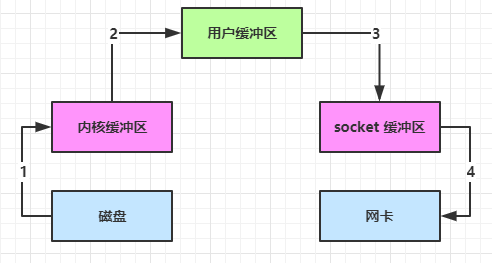
java 本身并不具备 IO 读写能力,因此 read 方法调用后,要从 java 程序的用户态切换至内核态,去调用操作系统(Kernel)的读能力,将数据读入内核缓冲区。这期间用户线程阻塞,操作系统使用 DMA(Direct Memory Access)来实现文件读,其间也不会使用 cpu
DMA 也可以理解为硬件单元,用来解放 cpu 完成文件 IO
从内核态切换回用户态,将数据从内核缓冲区读入用户缓冲区(即 byte[] buf),这期间 cpu 会参与拷贝,无法利用 DMA
调用 write 方法,这时将数据从用户缓冲区(byte[] buf)写入 socket 缓冲区,cpu 会参与拷贝
接下来要向网卡写数据,这项能力 java 又不具备,因此又得从用户态切换至内核态,调用操作系统的写能力,使用 DMA 将 socket 缓冲区的数据写入网卡,不会使用 cpu
可以看到中间环节较多,java 的 IO 实际不是物理设备级别的读写,而是缓存的复制,底层的真正读写是操作系统来完成的
- 用户态与内核态的切换发生了 3 次,这个操作比较重量级
- 数据拷贝了共 4 次
NIO 优化
通过 DirectByteBuf
- ByteBuffer.allocate(10) HeapByteBuffer 使用的还是 java 内存
- ByteBuffer.allocateDirect(10) DirectByteBuffer 使用的是操作系统内存

大部分步骤与优化前相同,不再赘述。唯有一点:java 可以使用 DirectByteBuf 将堆外内存映射到 jvm 内存中来直接访问使用
- 这块内存不受 jvm 垃圾回收的影响,因此内存地址固定,有助于 IO 读写
- java 中的 DirectByteBuf 对象仅维护了此内存的虚引用,内存回收分成两步
- DirectByteBuf 对象被垃圾回收,将虚引用加入引用队列
- 通过专门线程访问引用队列,根据虚引用释放堆外内存
- 减少了一次数据拷贝,用户态与内核态的切换次数没有减少
进一步优化(底层采用了 linux 2.1 后提供的 sendFile 方法),java 中对应着两个 channel 调用 transferTo/transferFrom 方法拷贝数据

- java 调用 transferTo 方法后,要从 java 程序的用户态切换至内核态,使用 DMA将数据读入内核缓冲区,不会使用 cpu
- 数据从内核缓冲区传输到 socket 缓冲区,cpu 会参与拷贝
- 最后使用 DMA 将 socket 缓冲区的数据写入网卡,不会使用 cpu
可以看到
- 只发生了一次用户态与内核态的切换
- 数据拷贝了 3 次
进一步优化(linux 2.4)

- java 调用 transferTo 方法后,要从 java 程序的用户态切换至内核态,使用 DMA将数据读入内核缓冲区,不会使用 cpu
- 只会将一些 offset 和 length 信息拷入 socket 缓冲区,几乎无消耗
- 使用 DMA 将 内核缓冲区的数据写入网卡,不会使用 cpu
整个过程仅只发生了一次用户态与内核态的切换,数据拷贝了 2 次。所谓的【零拷贝】,并不是真正无拷贝,而是在不会拷贝重复数据到 jvm 内存中,零拷贝的优点有
- 更少的用户态与内核态的切换
- 不利用 cpu 计算,减少 cpu 缓存伪共享
- 零拷贝适合小文件传输